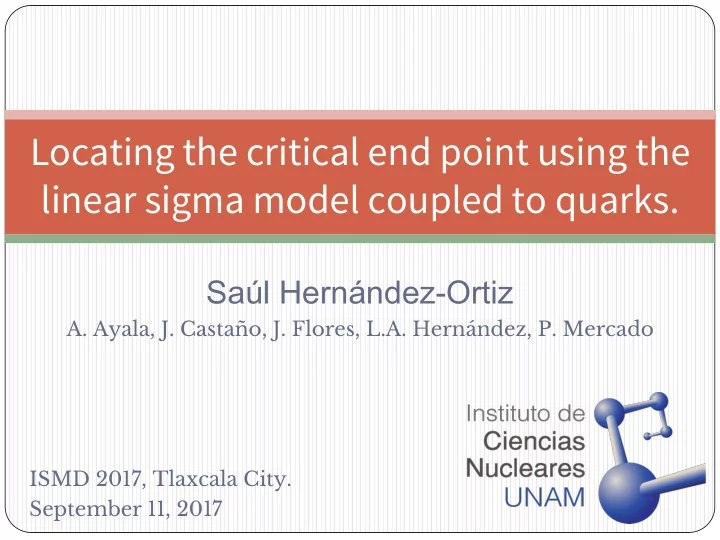

Locating the critical end point using the linear sigma model coupled to quarks. Saúl Hernández-Ortiz A. Ayala, J. Castaño, J. Flores, L.A. Hernández, P. Mercado ISMD 2017, Tlaxcala City. September 11, 2017
Outline ● Motivation ● The Linear Sigma model ● High Temperature Approximation ● Low Temperature Approximation ● Preliminary Results ● Final Comments 2
Motivation There are several phases of QCD. We are interested in studying the transition between these phases. ● High Energies ○ Asymptotic QCD freedom ● Low Energies ○ Confinement 3
Motivation ● QCD under extreme conditions (temperature and finite quark density) play an important role in understanding the transitions that took place in the early universe. 4
Motivation ● There is only reliable information at low densities. ● There are experimental efforts to dissipate doubts at higher densities. ○ NICA ○ RHIC(BES) ○ JPARC ○ FAIR 5
Linear Sigma Model ● Effective model for low-energy QCD. ● Effects of quarks and mesons on the chiral phase transition. ● Implement ideas of chiral symmetry and spontaneous symmetry breaking 6
Linear Sigma Model ● Lagrangian ● To allow for spontaneous symmetry breaking ● where is identified as the order parameter 7
Linear Sigma Model ● After the shift with masses 8
Linear Sigma Model ● We calculate the effective potential for fermions and bosons at finite temperature and quark chemical potential beyond the mean field approximation. , . where boson and fermion propagators are given by 9
High temperatures with Π the self energy ● For high temperatures we include the next term in the perturbative series, the ring diagrams (Dolan & Jackiw, Phys. Rev. D12 3320 (1974)) that considers screening properties of the plasma 10 M. Le Bellac, Thermal Field Theory (Cambridge Univ. Press, Cambridge 2000).
11
The parameter space consists of the λ and g coupling constants which are determined uniquely by the Goldstone boson mass at two fixed points Tapan Nayak-RHIC News (A) (B) 12
Low Temperature ● For high quark chemical potential, first we compute the effective potential at T=0 and finite μ, i.e. μb is a bosonic density that it is related with the quark chemical potential. 13
Low Temperature ● The low-T approximation can be obtained from its expression at T = 0 as where and are the derivate of Fermi-Dirac and Bose-Einstein distributions. (C. O. Dib & R. Espinosa, Nucl. Phys. B 612 , 492) 14
Low Temperature ● Now, for both potentials can be expanded in a Taylor series in because they varies slowly under the hump and then obtain the low temperature expansion. 15
Low Temperature 16
Coupling Constants ● Now, the system of equations to be solved for points A and B are 17
Coupling Constants ● Now the criterion to find the temperature and the chemical potential where the chiral symmetry is restored, is the following. ○ Second Order ○ First Order 18
For Details... Using the LSMq to describe the QCD phase diagram and to locate the CEP. Flores, José Antonio. 19
Preliminary Set of parameters: Results 1 20 1 MILC Collaboration, Phys. Rev. D 71 034504.
Preliminary Set of parameters: Results 1 21 1 MILC Collaboration, Phys. Rev. D 71 034504.
Locating QCD’s critical end point (with functional methods) Christian Fisher. 22
23
Final Comments ● Working in the LSMq, CEP is located in the region found by others effective models. ● We computed the effective potential and included plasma screening effects through the boson’s self energy. ● We found the CEP at 24
Many Thanks!!! Gracias!!! 25
Recommend
More recommend